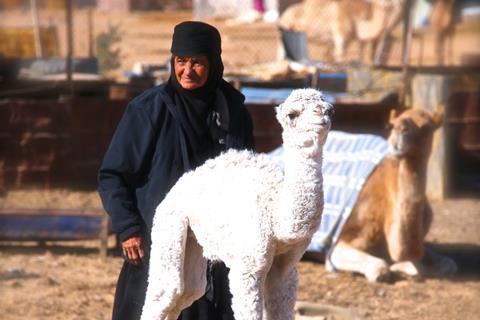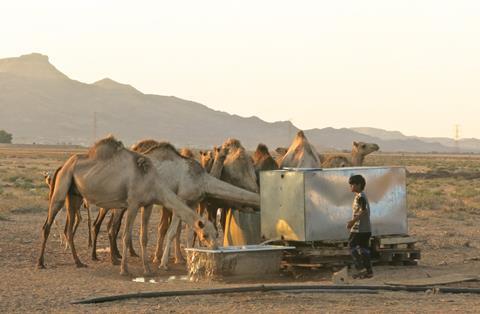New research led by the Royal Veterinary College (RVC) into the spread of MERS-CoV, the virus carried by camels which causes Middle East Respiratory Syndrome (MERS), has found that young camels present a high risk for human exposure to the virus, with kissing and petting young camels found to be an important route of viral transmission.

Like SARS-CoV-2, MERS-CoV is a respiratory virus and one of a small group of deadly zoonotic beta-coronaviruses to have emerged with global impact over the past two decades. Infection in camels causes only minor cold or flu symptoms, but infection in humans can be fatal. There have been more than 2,600 human cases identified to date, and 940 deaths reported across 27 countries.
Close-quarter exposure
Despite the high fatality rate among reported cases, zoonotic transmission pathways and camel subpopulations posing the highest risk have been poorly understood. However, this groundbreaking research identifies activities involving frequent close-quarter exposure to camel breath and nasal secretions as being high risk.
READ MORE: The threat of viral zoonosis hasn’t gone away
READ MORE: Mathematicians use AI to identify emerging COVID-19 variants
Young camels are known to shed high volumes of the virus when infected, due to lack of previous immunity, and kissing and petting is common practice among many camel-owning communities in the Middle East – where the animals are highly revered and cherished, above other livestock. The physical size of camels places their muzzles at human head height and activities such as feeding and watering, where camels crowd around individuals carrying feed sacks of filling troughs, were also found to be high risk.
Study findings, recently published in the journal Lancet Microbe, demonstrated that human-to-human transmission of the virus also appears to be happening in family household settings, with household members without camel contact showing evidence of viral exposure if sharing the household with other members who are positive, particularly those with camel contact. Diabetic household members were found to be particularly at risk of infection.
Camel race danger
Camel races were also found to be a high-risk environment for infection, with potential for both primary (camel-to-human) and secondary (human-to-human) transmission to occur.
The research was conducted by the RVC alongside experts from the London School of Hygiene & Tropical Medicine (LSHTM), Rocky Mountain Laboratories (NIH), Jordan University of Science and Technology (JUST), Yarmouk University and the Jordanian government. The research was a cross-sectional study between September 2017 and October 2018 and encompassed 879 people comprising 204 livestock-owning households in southern Jordan.
Findings highlight the importance of effective surveillance activities for the virus across the Arabian Peninsula and help identify which groups of humans and camels should be prioritised when vaccines currently in development become available.
Zoonotic transmission
Javier Guitian, Professor of Veterinary Public Health at the RVC, said: “This study represents one of the largest epidemiological investigations of MERS-CoV among high-risk populations since the virus was first identified in Saudi Arabia in 2012. Our findings highlight the role of contact with juvenile dromedary camels and attendance at camel races in zoonotic transmission. Additionally, we provide evidence in support of within-household transmission among camel-owning communities. Effective surveillance among these high-risk groups remains a global health priority.
“When camel vaccines currently under development become available, young camels should be prioritised for vaccination. Public health education in camel-owning communities should aim to raise awareness and reduce the risk of zoonotic exposure, particularly through young camels’ nasal secretions.

“We are very grateful for all the support we’ve received from project partners and funders. This has allowed us to establish a multidisciplinary research team and build a relationship of trust with communities in Southern Jordan, which are central in confronting the global challenge posed by MERS-CoV.”
Combined effort
Punam Mangtani, Professor in Epidemiology at LSHTM, said: “I am pleased to see our combined veterinary and human epidemiological research with Jordanian and US experts has been able to successfully investigate factors involved in the transmission of MERS-CoV across the animal-human interface.
“Although we were aware that young camels shed high viral loads, we have now shown that these animals also pose a higher risk of viral transmission to humans. We have, in addition, shown in this serosurvey of camel-owning compared to other livestock-owning households, that antibodies giving an indication of past infections were also present in household members not in direct contact with camels. This indirect evidence suggests the occurrence of asymptomatic transmission to household members, some of whom may be frailer and more susceptible to severe disease from MERS-CoV infection.
“The findings give greater urgency to co-create with affected communities, effective and acceptable interventions in to reduce spillover infections from camels, the reservoir for MERS-CoV, to humans.”
The study was funded by UK Research and Innovation (UKRI). This work builds upon the long-standing relationship that exists between the RVC and partners at LSHTM, NIH and JUST – the relationship with JUST being first initiated through a World Organisation for Animal Health twinning initiative, with support from the UK Defence, Science and Technology Laboratory and British Embassy in Jordan.
Topics
- camels
- Emerging Threats & Epidemiology
- Healthy Land
- Infectious Disease
- Javier Guitian
- Jordan
- Jordan University of Science and Technology
- London School of Hygiene & Tropical Medicine
- MERS-CoV
- Middle East & Africa
- One Health
- Punam Mangtani
- Research News
- Rocky Mountain Laboratories
- Royal Veterinary College
- UK & Rest of Europe
- Veterinary Medicine & Zoonoses
- Viruses
- Yarmouk University







No comments yet